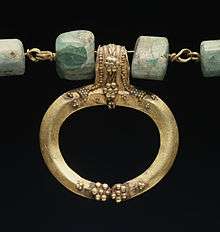Lunula (amulet)
A lunula (plural: lunulae) was a crescent moon shaped pendant worn by girls, the equivalent of the boy's bulla, girls ideally wore them as an apotropaic amulet. In the popular belief the Romans wore amulets usually as a talisman, to protect themselves against evil forces, demons and sorcery, but especially against the evil eye.
In Plautus' play, Epidicus asks the young girl Telestis: "Dont you remember my bringing you a gold lunula on your birthday, and a little gold ring for your finger?". Isidore of Seville provides an explicit definition: "Lunulae are female ornaments in the likeness of the moon, little hanging gold bullae". But in Plautus' play Rudens, Palaestra says her father gave her a golden bulla on the day of her birth. There is also some indication that babies of both sexes wore phallic amulets.[1]
Upon the eve of marriage, the lunula would be removed, but instead of being saved, it would be burned with the rest of her childhood toys. There is much speculation as to what this signifies, but many say that it represents the beginning of the next phase of life.[2]
See also
References
- ↑ cf. Pliny HN 28.39
- ↑ "Ancient Roman Amulets". Ancient Roman Goods. Retrieved 2013-07-29.
- J. C. Edmondson, Alison Keith, eds. (2008). Roman Dress and the Fabrics of Roman Culture. University of Toronto Press. pp. 42n20, 143–5, 148–9, 152nn45–6, 155n62. ISBN 978-0-8020-9319-6.
- Kelly Olson (2008). Dress and the Roman Woman: Self-Presentation and Society. Routledge. pp. 16, 18. ISBN 978-0-415-41476-0.
External links
![]() The dictionary definition of lunula at Wiktionary
The dictionary definition of lunula at Wiktionary
- Artefacts - Amulet : phallus on lunula (AMP-4016)
- The Magic of the Horseshoe: Crescents and Half-moon-shaped amulets
- Archeological finds from the Netherlands of the Rijksmuseum van Oudheden
